Key Publications
 Nutrition-sensitive agriculture water productivity: Insights from field implementation
Nutrition-sensitive agriculture water productivity: Insights from field implementation
The policy brief outlines insights from field implementation of the nutrition-sensitive agriculture water productivity project in Benin, Mozambique and Niger, specifically the methodological approach, highlights from baseline surveys and next steps to ensure that the aforementioned agricultural practices lead to greater dietary quality and diversity, improvements in health, and expanded livelihoods.
 Water productivity,
the yield gap, and nutrition: The case of Ethiopia.
Water productivity,
the yield gap, and nutrition: The case of Ethiopia.
The publication discusses the relationship between nutrition and water in the context of water challenges based on the assumption that increasing water productivity and reducing yield gap can pave the way to a diversification in cropping patterns and environmentally sound food systems that benefit both farmers and society.
 Accounting for
livestock water productivity: How and why?
Accounting for
livestock water productivity: How and why?
The report reviews current applications of water productivity in livestock supply chains in order to primarily shape the foundations for an assessment methodology enabling to inform decisions in sustainable water management and nutrition sensitive agricultural practices at the producer level. The review recommends the further development of guidelines that ensure a consistent and coordinated application of water productivity analysis of livestock production systems worldwide.
Other Publications
FAO’s work in nutrition: Raising nutrition for all
FAO’s mandate includes raising levels of nutrition. The Strategic Framework 2022-31 commits FAO to work for MORE efficient, inclusive, resilient and sustainable agri-food systems for better production, better nutrition, a better environment, and a better life, leaving no one behind. Through FAO’s work in nutrition, the organization will tackle malnutrition in all its forms by accelerating impactful actions and policies that create efficient, inclusive, resilient and sustainable agri-food systems. Such systems are essential to achieving a world where everyone can access, afford and consume a healthy diet.
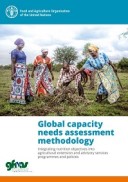 Global Capacity Needs Assessment Methodology
Global Capacity Needs Assessment Methodology
The agricultural sector is able to provide food of sufficient quantity and quality to feed and nourish the world’s population. However, capacity-development efforts need to be strengthened among agricultural extension and advisory services through a systematic approach based on a better understanding of needs, challenges and interactions at and among all institutional levels. The Global Capacity Needs Assessment (GCNA) methodology examines the capacity gaps at the individual, organizational and enabling-environment levels.
 Nutrition and the perfect storm of water
Nutrition and the perfect storm of water
Water,
malnutrition, poverty, climate change and demography are the big five challenges that jeopardize pledges for progress. Making use of untapped opportunities in food systems to overcome low productivity, low diversity and to realize nutrition benefits and
income opportunities requires a double coordination: timely management of water and other inputs in agriculture, and a coordination with WASH services.
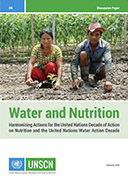 Water and Nutrition:
Harmonizing actions of the United Nations decade of action on nutrition and the
United Nations water action decade.
Water and Nutrition:
Harmonizing actions of the United Nations decade of action on nutrition and the
United Nations water action decade.
This paper reviews several challenges, including environmental and climate change, as part of a broader analysis of the complex web of pathways that link water, food security and nutrition outcomes. Climate change and the growing demand for water resources are also considered, given their central role in shaping future water and nutrition security.
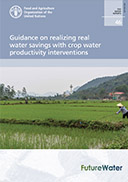 Guidance on realizing real water savings with crop water productivity interventions. Find out the new FAO Water Report!
Guidance on realizing real water savings with crop water productivity interventions. Find out the new FAO Water Report!
This technical document contains clear and practical guidelines on how to implement real water savings in agriculture through interventions for enhancing crop water productivity. A distinction is made between real water savings and “apparent” water savings. Apparent water savings record reductions in water withdrawals but do not account for changes in water consumption. Real water savings record reductions in water consumption and non-recoverable return flows (runoff or percolation).
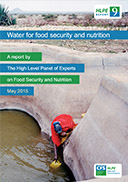 Water for Food Security and Nutrition
Water for Food Security and Nutrition
This policy-oriented report from the High Level Panel of Experts on Food Security and Nutrition (HLPE) presents a synthesis of existing evidence on the multiple relations between water and food security and nutrition, from global levels to household levels. The aim of this report, given the diversity of contexts, is to help all concerned actors to improve water management, and management of agricultural and food systems for water, and to improve water governance
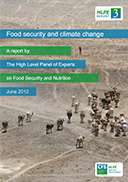 Food Security and Climate Change
Food Security and Climate Change
Food insecurity and climate change are, more than ever, the two major global challenges humanity is facing, and climate change is increasingly perceived as one of the greatest challenges for food security. This report calls attention to the urgent need for action at all levels, starting with local communities and extending up to global organizations.
 The Global Strategic Framework for Food Security and Nutrition
The Global Strategic Framework for Food Security and Nutrition
The goal of the CFS Global Strategic Framework for Food Security and Nutrition (GSF) is to provide an overarching framework and reference point for food security and nutrition strategies, policies and actions. The GSF offers guidelines and recommendations for coherent and coordinated actions at global, regional and national levels that can support countries in their efforts to achieve the SDGs.
Voluntary guidelines on food systems and nutrition
These guidelines present a concrete inter-governmental and multi-stakeholder negotiated policy tool for use by governments, specialized institutions and other stakeholders to develop appropriate policies, responsible investments and institutional arrangements to address the causes of hunger and malnutrition in all its forms, from a food systems perspective. The Voluntary Guidelines present a wide range of recommendations to promote policy coherence and reduce policy fragmentation between relevant sectors - health, agriculture, education, environment, gender, social protection, trade and employment - all of which impact food systems and nutrition.
